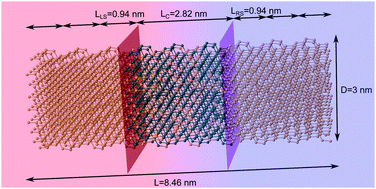Tuning thermal transport in Si nanowires by isotope engineering†
Abstract
We study thermal transport in isotopically disordered Si nanowires, discussing the feasibility of phonon engineering for thermoelectric applications within these systems. To this purpose, we carry out atomistic molecular dynamics and nonequilibrium Green's function calculations to characterize the dependence of the thermal conductance as a function of the isotope concentration, isotope radial distribution and temperature. We show that a reduction of the conductivity of up to 20% can be achieved with suitable isotope blends at room temperature and approximately 50% at low temperature. Interestingly, precise control of the isotope composition or radial distribution is not needed. An isotope disordered nanowire roughly behaves like a low-pass filter, as isotope impurities are transparent for long wave-length acoustic phonons, while only mid- and high-frequency optical phonons undergo significant scattering.



 Please wait while we load your content...
Please wait while we load your content...